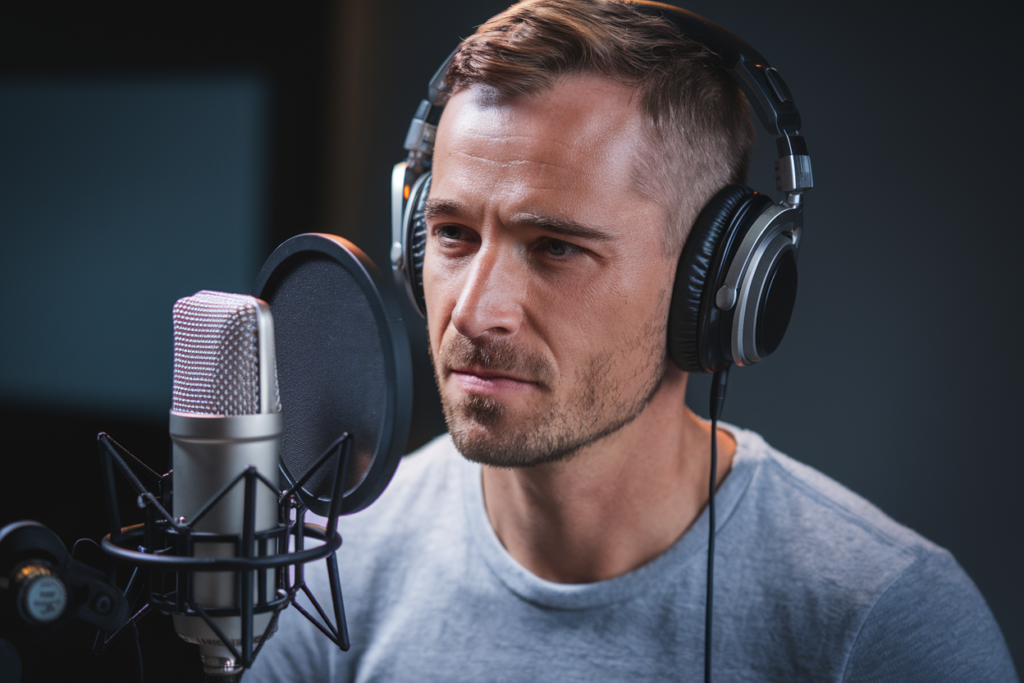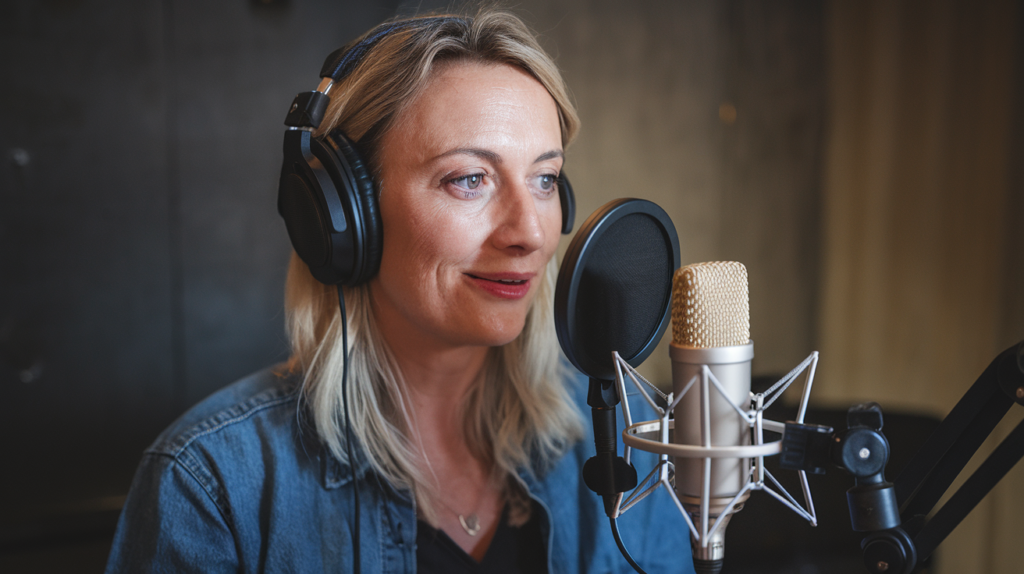Key Takeaways
- Understanding Lip Sync: Achieving lip sync in French dubbing combines technical skill with artistic expression, ensuring dialogue matches the original actors’ mouth movements for enhanced viewer immersion.
- Importance of Timing: Precise timing and rhythm are crucial; voice artists must deliver lines that align with the pacing of the original performance to create a seamless experience.
- Character Integrity: Maintaining character integrity is vital, requiring voice actors to embody each character’s essence while delivering authentic performances that resonate with audiences.
- Techniques for Success: Techniques such as voice matching and phoneme alignment play significant roles in achieving effective lip sync, enhancing overall production quality.
- Utilizing Tools: Specialized audio editing software and visual alignment tools streamline the dubbing process, improving both audio clarity and visual synchronization.
- Navigating Challenges: Language differences and cultural nuances present challenges during dubbing; skilled voiceover artists must adapt dialogues creatively while preserving emotional resonance.
Ever wondered how those French films seem so perfectly in sync with the dialogue? Achieving lip sync in French dubbing for France isn’t just a technical challenge; it’s an art form that can make or break a viewer’s experience. When done right, it transforms a good film into an immersive masterpiece.
Understanding Lip Sync in French Dubbing
Achieving lip sync in French dubbing requires a blend of technical skill and artistic expression. You want the dialogue to match the original actors’ mouth movements closely, ensuring a seamless viewing experience. This synchronization enhances viewer immersion, making it feel as though the characters are speaking naturally in their language.
A key factor is timing. Voice artists must deliver lines with precision, matching the rhythm and pacing of the original performance. You might find that adjusting the script can help make lines fit more comfortably within the visual constraints. Considerations like syllable count and stress patterns play crucial roles here.
Another important aspect is character alignment. Different voice actors bring unique interpretations to their roles, affecting how they sound and appear on screen. Selecting voice talent who can embody these characters authentically ensures that your dubbed version resonates well with French audiences.
Moreover, using high-quality recording equipment makes a significant difference in clarity and impact. You’ll want to ensure that each line captures not just words but also emotions and intentions behind them. When done right, this attention to detail elevates your project from good to great.
Ultimately, effective lip sync transforms dubbing into an art form where every element—from script adjustments to voice performances—comes together harmoniously. Engaging viewers through authentic character portrayals keeps them invested in your story while enhancing overall satisfaction with the film or show.
Importance of Lip Sync in Dubbing
Lip sync plays a crucial role in dubbing, especially in French productions. It significantly impacts how audiences perceive and enjoy films or shows. When done correctly, lip sync enhances immersion, allowing viewers to connect with characters on a deeper level.
Enhancing Viewer Experience
Effective lip sync elevates the viewing experience by creating a seamless connection between dialogue and visuals. When your voice talent delivers lines that match mouth movements precisely, it feels natural. This authenticity draws viewers into the story, making them forget they’re watching a dubbed version. Think about it: when you watch a film where the dialogue aligns perfectly with what’s happening on screen, you engage more fully with the characters and plot.
Maintaining Character Integrity
Maintaining character integrity is vital for successful dubbing. Your voice actor must embody the essence of each character while ensuring their performance aligns with the original intent. This means capturing not only words but also emotions through vocal inflection and timing. A skilled voice over artist can replicate nuances that convey personality traits and emotional states effectively.
When these elements come together—timely delivery matched to visuals and authentic character portrayal—you achieve true artistry in dubbing. The result? An engaging experience that resonates with audiences long after they’ve finished watching.
Techniques for Achieving Lip Sync
Achieving lip sync in French dubbing involves specific techniques that enhance the overall quality of the production. These methods ensure that viewers remain immersed in the story without being distracted by mismatched audio and visuals.
Timing and Rhythm
Timing and rhythm play critical roles in creating effective lip sync. Voice artists must deliver their lines with precision, aligning their speech patterns to match the original performance’s cadence. This requires careful attention to pacing; a well-timed delivery can make dialogue feel natural rather than forced. You’ll notice that when voice talent captures the essence of timing, it elevates the entire viewing experience, making it seamless for audiences.
Voice Matching
Voice matching is another essential technique for achieving lip sync. It’s crucial for voice actors to replicate not just the tone but also the character’s personality and emotional state present in the original performance. When voiceover talent successfully embodies these characteristics, it fosters a connection between viewers and characters on-screen. The right vocal inflection can breathe life into a role, making every line resonate authentically with its intended emotion.
Phoneme Alignment
Phoneme alignment focuses on matching individual sounds or phonemes from one language to another. This technical aspect requires meticulous effort from voice artists as they adjust pronunciations to fit mouth movements accurately. By ensuring that each phoneme aligns closely with visual cues, you create a more immersive experience for viewers who may not be fluent in French but still appreciate high-quality dubbing work.
Utilizing these techniques collectively enhances lip sync accuracy, leading to an engaging viewing experience where audiences forget they’re watching a dubbed film altogether.
Tools and Software for Lip Sync
Achieving precise lip sync in French dubbing relies on specialized tools and software that streamline the process. These resources enhance both audio quality and visual alignment, allowing voice actors to deliver authentic performances.
Audio Editing Software
Audio editing software plays a pivotal role in achieving high-quality sound during the dubbing process. Programs like Adobe Audition or Audacity allow you to edit recordings, ensuring clarity and professionalism. Key features include:
- Noise Reduction: Remove background noise to maintain focus on dialogue.
- Equalization: Adjust frequencies for optimal vocal clarity.
- Time Stretching: Alter the timing of voiceovers without affecting pitch, perfect for aligning with original mouth movements.
These functionalities enable you to refine your audio tracks meticulously, ensuring they match the action on screen flawlessly.
Visual Alignment Tools
Visual alignment tools are essential for syncing audio with video effectively. Programs such as Avid Media Composer or Final Cut Pro provide features specifically designed for this purpose. Important capabilities include:
- Waveform Visualization: Analyze audio waveforms alongside visuals to ensure precise matching.
- Frame-by-Frame Editing: Allow adjustments at specific intervals, crucial when fine-tuning dialogue delivery to character movements.
- Lip Sync Markers: Identify key moments where synchronization is critical, helping voice actors align their performances tightly with visuals.
Using these tools enhances your ability to create a seamless viewing experience that captivates audiences and keeps them engaged throughout the film.
Challenges in Achieving Lip Sync
Achieving lip sync in French dubbing presents several challenges that voice actors must navigate skillfully. These challenges stem from language differences and cultural nuances, both of which play a significant role in creating an immersive viewing experience.
Language Differences
Language differences contribute to the complexity of lip sync. French often has longer words compared to English, which can disrupt timing when matching dialogue to visual cues. For instance, a phrase that fits perfectly in English might require additional syllables or alterations in French. Voice artists must adapt their delivery while maintaining the essence of the original performance, ensuring emotional resonance remains intact.
Phoneme alignment further complicates matters. Each language has unique sounds that don’t always translate directly. Voice talents need to closely examine these phonetic variations and adjust their performances accordingly. This meticulous work ensures that each sound aligns with the corresponding mouth movement on screen, enhancing viewer engagement.
Cultural Nuances
Cultural nuances also pose challenges during dubbing efforts. Different cultures express emotions and humor uniquely, affecting how lines are delivered and perceived by audiences. Voice actors must embody not only the character’s voice but also their personality traits and social context within the narrative.
Understanding cultural references is crucial for effective translation too. Some jokes or idiomatic expressions simply don’t carry over well from one language to another; they may lose meaning or impact entirely if translated literally. Skilled voiceover artists recognize these subtleties and adjust dialogues creatively so they resonate with French-speaking viewers while remaining true to the original intent.
Navigating these complexities requires collaboration among translators, directors, and voice talent throughout the dubbing process. This teamwork fosters authentic performances that truly reflect both linguistic accuracy and cultural relevance—key elements necessary for achieving successful lip sync in any project.
Conclusion
Mastering lip sync in French dubbing is a blend of technical precision and artistic expression. By honing your timing and rhythm while embodying the character’s essence, you can create an authentic experience that resonates with viewers. Utilizing advanced tools and software enhances your ability to match dialogue with visual cues seamlessly.
Navigating language differences and cultural nuances adds complexity but also enriches the performance. Collaboration among all parties involved ensures that every aspect aligns perfectly. When done right, effective lip sync transforms the viewing experience, allowing audiences to connect deeply with the characters on screen. Embrace these techniques to elevate your dubbing projects and captivate your audience like never before.
Frequently Asked Questions
What is lip sync in French dubbing?
Lip sync in French dubbing refers to the technique of aligning voice recordings with the mouth movements of characters on screen. It ensures that dialogue matches the visual cues, enhancing audience immersion and enjoyment.
Why is proper lip sync important?
Proper lip sync enhances viewer experience by making dubbed films feel more natural and engaging. When executed well, it allows audiences to connect emotionally with characters, making them forget they are watching a dubbed version.
What challenges do voice actors face in achieving lip sync?
Voice actors encounter challenges like language differences, cultural nuances, and phoneme alignment. Longer words in French can disrupt timing, while unique sounds may not translate directly. These factors require careful adjustment for accurate synchronization.
How does timing affect lip sync accuracy?
Timing is crucial for delivering lines that align with the original performance’s rhythm. Voice artists must match their speech patterns precisely to create a seamless experience where dialogue flows naturally with visual actions.
What tools are used for achieving precise lip sync?
Specialized audio editing software like Adobe Audition and Audacity helps refine sound quality, while video editing tools such as Avid Media Composer and Final Cut Pro assist in syncing audio to visuals effectively.
How do cultural nuances impact dubbing?
Cultural nuances influence how emotions and humor are expressed in different languages. Voice actors must understand these subtleties to deliver authentic performances that resonate with audiences while staying true to the original intent.
What techniques enhance lip sync accuracy?
Key techniques include timing and rhythm adjustments, voice matching for tone consistency, phoneme alignment for sound synchronization, and capturing emotional nuances through vocal inflection—all critical for effective dubbing performance.







